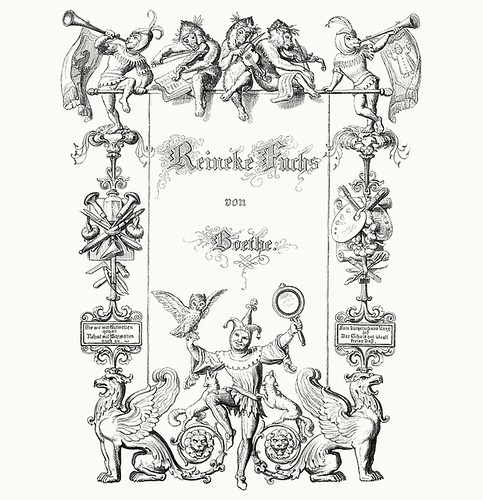
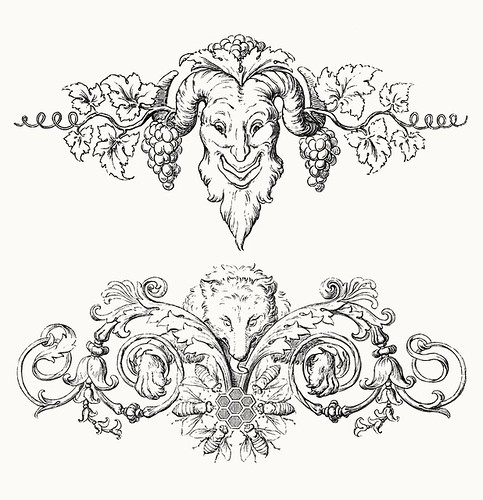
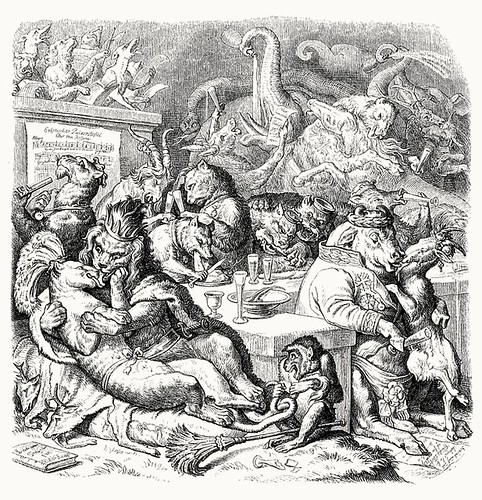
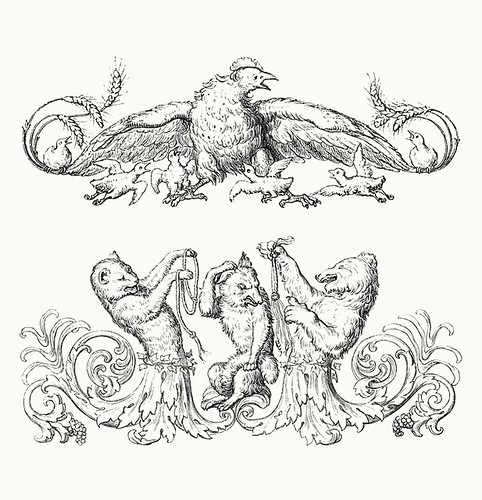
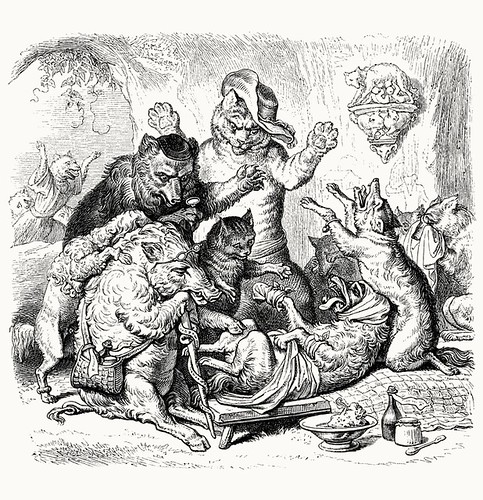
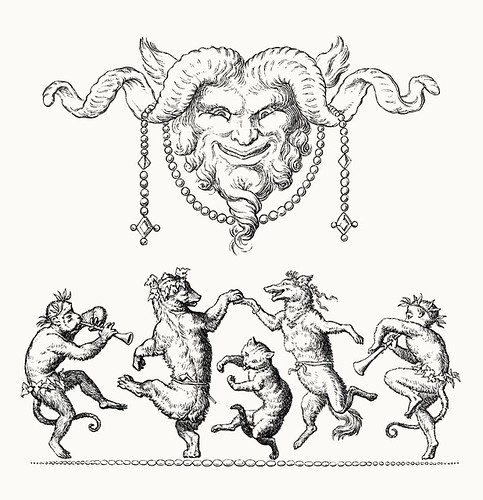
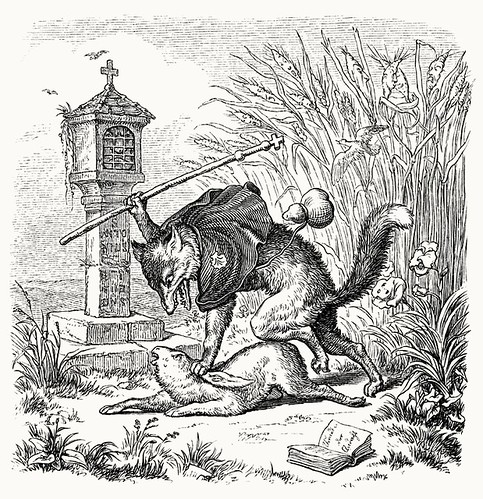

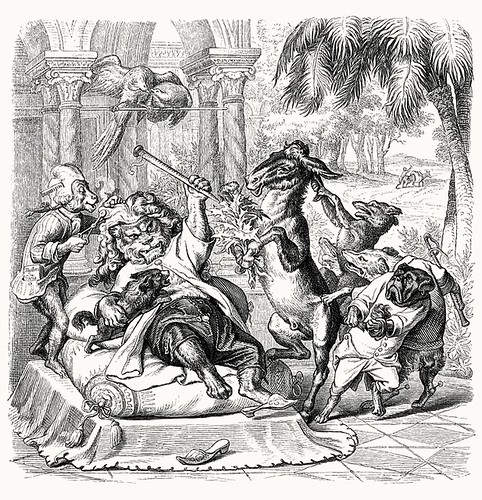
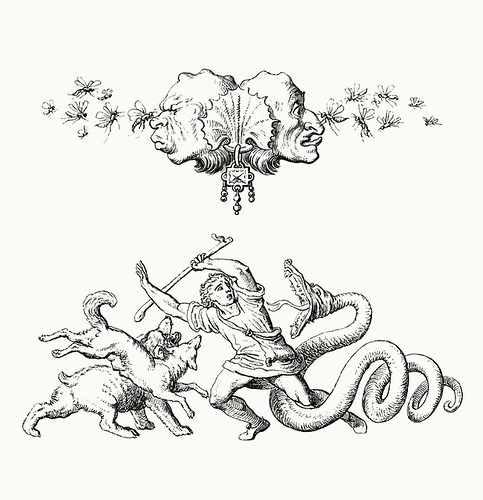
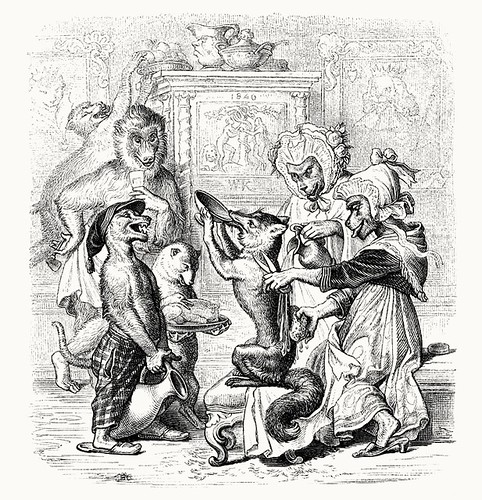
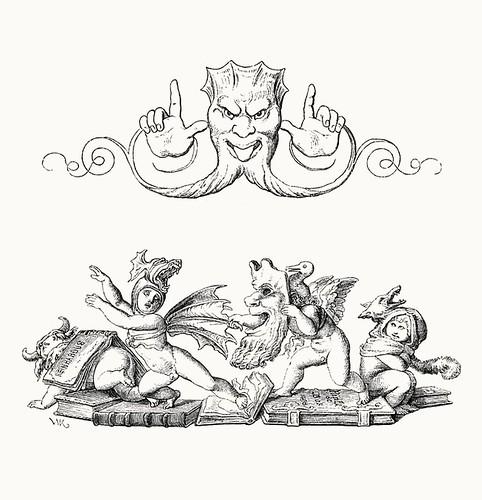
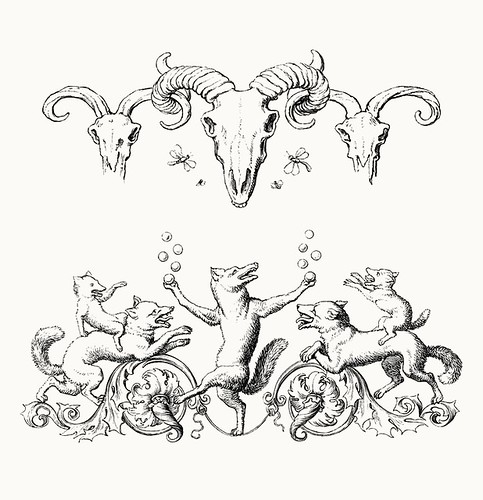
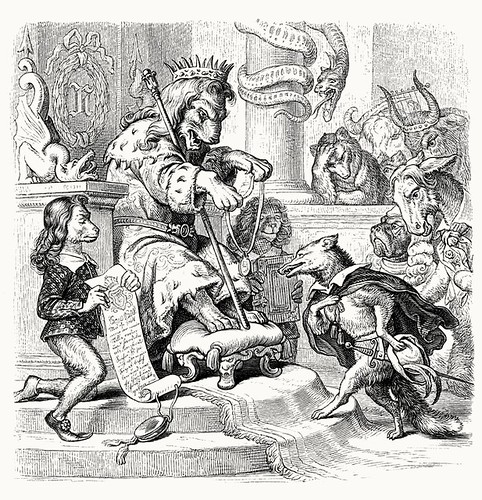
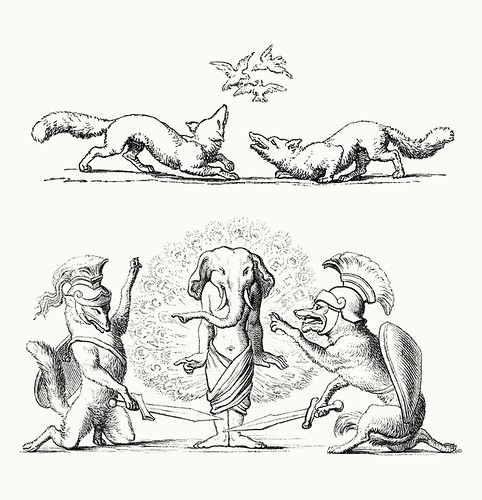
With roots stretching back to Aesop's Fables and the oral folk tradition, the allegorical tales of Reynard the Fox ('Reineke Fuchs') emerged in the 12th century as a storytelling convention, becoming conspicuously popular in Germany, France and Holland.
One of the common structural themes around which the assorted tales frequently revolved has the rogue hero Reynard outwitting a royal court when he is brought up on charges laid by other forest animals. Recurring characters include the wily Reynard, King Noble the lion, Isengrim the wolf, Bruin the bear, Baldwin the ass and Tibert (Tybalt) the cat.
Always humorous, often in verse form, the assortment of fables satirised the contemporary societies in which they were developed, resulting in "the subversion of certain kinds of serious literature, of political and religious institutions and practices, of scholarly argument and moralizing, and of popular beliefs and customs". The shameless and self-serving fox emerges as the peasant hero with his display of contempt for the upper classes. The anthropomorphic animals in the stories could of course be adjusted to symbolise real political or clerical figures or broad allegorical concepts to fit the prevailing mood as desired.
Germany's great writer, Wolfgang von Goethe, adapted a medieval version of Reynard the Fox to produce an epic poem in hexameter in 1794 - 'Reinecke Fuchs' - which is thought to have been influenced by the events of the French Revolution. German artist Wilhelm von Kaulbach produced an elaborate set of steel engravings in the 1840s (therefore, interestingly, he was a contemporary of JJ Grandville**) which were first published in the 1846 edition of 'Reinecke Fuchs'. The images above are derived from an 1857 facsimile edition. I can't imagine this was intended as a childrens book - there is some bawdy and fairly sophisticated imagery present, but maybe it's just my modern perspective/expectations and this was actually good and proper fare for a 19th century child (?).
**Brief searches revealed that a combined book of Grandville's classic 19th century anthropomorphic satire 'Les Metamorphoses du Jour' and Kaulbach's 'Reinecke Fuchs' series of illustrations was published at one stage. There was no indication that the two had met and I think that Kaulbach was the more famous artist, at least during the 1840s. [Grandville]
- The above 'Reinecke Fuchs' engravings -- the selection I've picked concentrates on the chapter vignettes, humorously riffing on illuminated manuscript and grotesque themes; while the fable illustrations proper are from near the end of the page-by-page book -- are available from the always excellent Coconino Classics collection.
- All of the fable illustrations (a different, photographed version - arguable which is better quality I guess) are accessible from a single thumbnail page at the Christian von Kamp site.
- Reynard the Fox 1911 Encylopedia (copy).
- Reynard the Fox at Cornellbooksellers.
- The History of Reynard the Fox - a modernised version of William Claxton's original 15th century translation of the tales into english.
- 'Reynard the Fox: Social Engagement and Cultural Metamorphoses in the Beast Epic from the Middle Ages to the Present. - book review'
- Reynard the Fox at Columbia Encylopedia. [wikipedia - not great]
- Wilhelm von Kaulbach biographies: Web Gallery of Art/wikipedia. [Artcyclopedia]



















11 comments :
...this was actually good and proper fare for a 19th century child (?).
It might have been considered so - after all, Hoffman's Struwwelpeter was pubished in 1845:
http://upload.wikimedia.org/wikipedia/commons/e/ec/H_Hoffmann_Struwwel_08.jpg
So she was burnt with all her clothes,
And arms and hands, and eyes and nose;
Till she had nothing more to lose
Except her little scarlet shoes;
And nothing else but these was found
Among her ashes on the ground.
Good point. That's got to be one of the most famous childrens books illustrations ever.
I was more in the way of thinking out loud rhetorically. The actual text of Goethe's version is available somewhere (I didn't keep the link because it was pretty awful formatting) but I'd need to be told whether or not it was actually aimed at kids or not (because this is generally a non-english fable tradition, there's not a whole lot of commentary around actually).
It just kind of feels incongruous - the stuffy prudish Victorian era contrasting with startling childrens book illustrations.
Orgies for the New Year, I see!
As to the child-suitability issue, my impression is that (rather like today) it was fine to have tales of violent death but perhaps not to show all that lewd interspecies slurpy kissing.
That's an excellent point about Struwwelpeter.
I believe that Darnton's well-known Great Cat Massacre (the first essay I believe?) would be one of the better sources to refer to for a good perspective on such children's literature. Apparently fairy tales were a whole lot more exciting and racy before the Grimms got to them.
As an early modern German and Dutch historian (ABD), I'd have to say that raunchy literature was enjoyed by children and their parents alike before the mid 18th century. In my areas at least, they'd have seen this imagery (that of Renard or similar characters) in public art as well in public theater (such as during Carnival).
I was more in the way of thinking out loud rhetorically.
Me too - the malleability of what childhood means (time/place/class/culture) has fascinated me for some time...
Hi BibliOdyssey,
I'm trying to figure out what the text says on the engraving from the pg 31 (coconino) image of the fox beating up the rabbit. i need the text on the book at the book at the bottom right corner. if you can help me out in any way, i'd be most appreciative!
thanks
whateverfiles
the siv, I can't tell by looking at it I'm afraid. The 3rd word rings a bell but for no specific reason. I don't know German so come up against it all the time and have possibly remembered 'the look' of the word from somewhere else. Good luck though.
you might really appreciate these...
http://tomsachs.org/exhibition/18360-gold--plywood
Thanks a lot Alex. Excellent set.
(I kept thinking: "haven't I seen this before?" but it's probably just from being familiar with the originals)
did you see the animals show too? there are some pieces that are also RF:
http://www.tomsachs.org/exhibition/18319-animals
Ah, gotcha. Good stuff.
Post a Comment
Comments are all moderated so don't waste your time spamming: they will never show up.
If you include ANY links that aren't pertinent to the blog post or discussion they will be deleted and a rash will break out in your underwear.
Also: please play the ball and not the person.
Note: only a member of this blog may post a comment.